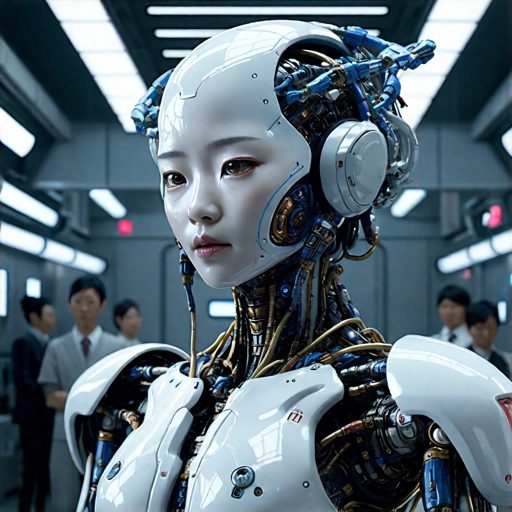
Japan’s Labor Crisis and the Promise of Artificial Intelligence
Recommended for AI
In the heart of a nation obsessed with flawless craftsmanship, even the tiniest blemish on a dumpling can spell disaster. Osaka Ohsho, a renowned gyoza purveyor, knows this all too well. Surging demand during the pandemic stretched its workforce thin, but technology offered a lifeline.
In January 2023, they unveiled a futuristic factory where AI-powered cameras hunt for imperfections, enabling them to churn out a staggering two dumplings every single second.
It’s a race against time. Every dumpling, every detection, is a stitch in the fabric of a solution to Japan’s looming labor shortage.
Artificial Intelligence (AI): When Robots Become Chefs
The ripple effects of Japan’s shrinking and aging population reverberate across its economy. At one Tokyo restaurant, an AI-powered robot named I-Robo has taken its place in the kitchen. This culinary automaton is a master of its domain, tirelessly preparing dishes to stem the tide of missing chefs.
The whir of motors and the sizzle of the griddle blend into a symphony of technological innovation. Each stir-fry is a testament to AI’s potential in easing the burden on Japan’s dwindling workforce.
The Ticking Clock: A Demographic Time-bomb
Japan’s population has been steadily declining for over a decade, with the percentage of citizens over 65 now a staggering 29%. This, coupled with one of the lowest birth rates globally, has made the labor shortage a crisis in the making. By 2040, the country could lack up to 11 million workers, threatening the very fabric of Japan’s society.
Imagine a bustling city gradually falling silent, its streets and workplaces slowly emptying with each passing year. That’s the looming reality facing Japan, a crisis Prime Minister Fumio Kishida describes as pushing the country to the “brink” of dysfunction.
Since a surge of AI development swept across the world, a burning question has lingered: will machines take our jobs? In Japan, the answer may well be a hopeful “Yes, please!” AI isn’t just a buzzword here – it’s a potential lifeline.
Farming 2.0: Artificial Intelligence (AI) Diagnosesailing Crops
Farming isn’t often considered cutting-edge, but AI is transforming the fields. The average Japanese farmer is almost 69 years old, making the industry ripe for disruption.
Companies like Nihon Nohyaku have developed apps like “Nichino AI,” where farmers upload photos of ailing crops to receive AI-powered diagnoses and treatment recommendations.
Sunlight glints off the visor of an aging farmer as he scans his struggling crops through the lens of his smartphone. It’s a scene worthy of a sci-fi film, where the weapons against blight and pests are algorithms rather than chemicals.
“Sensei Bot”: AI Teaches English
Despite years of effort, English fluency in Japan remains low, largely due to a lack of teachers. Enter ventures like Ecumenopolis, with its AI-powered online tutor. Students engage in 15-minute conversations with an AI avatar, receiving personalized feedback on pronunciation, grammar, and more.
While this tool offers practice opportunities, even students admit it lacks the human touch that truly fosters language learning.
*In a classroom buzzing with hushed chatter, students stare intently at screens. Their conversational partners aren’t flesh and blood, but lines of code, patiently parsing awkward grammar and gently correcting pronunciation. *
City Hall Upgrades: Artificial Intelligence (AI) as Bureaucratic Assistant
Even the Japanese government is experimenting with AI’s capabilities. Cities like Yokosuka are using AI chatbots like ChatGPT to tackle administrative tasks, such as transcribing meetings. The benefits are immense: reduced workload and a staggering 22,700 hours of work saved annually.
Picture row upon row of neat cubicles, where screens reflect the focused expressions of city workers. But something’s different – a quiet AI revolution is underway, streamlining processes that once consumed countless worker-hours.
The Road Ahead: Hand in Hand with Humans
While AI surges forward, offering efficiency gains and potential solutions, it’s vital to remember its limitations. Japan’s embrace of AI is fueled by necessity. Yet, even amidst a crisis, experts recognize that AI is a tool, not a wholesale replacement for workers.
For a deeper look at how AI might reshape the future of work, explore this analysis from the World Economic Forum!
Related Stories
Watch a video
Artificial Intelligence: The surprising key to revolutionizing education? Sal Khan explains.
Curious Times is a leading newspaper and website for kids. We publish daily global news aligned to your learning levels (also as per NEP 2020): Foundational, Preparatory (Primary), Middle and Senior. So, check out the News tab for this. We bring kids’ favourite Curious Times Weekly newspaper every weekend with top news, feature stories and kids’ contributions.
Curious Times News Program for Schools for FREE. Over 5,000 schools and teachers from all over the world have joined our programme so that students and teachers can get FREE Educative Newspaper. Here, kids can take part in world events and win prizes and certificates for free through their schools.
The following social media platforms allow you to communicate with us: Instagram.
0 (Please login to give a Curious Clap to your friend.)
